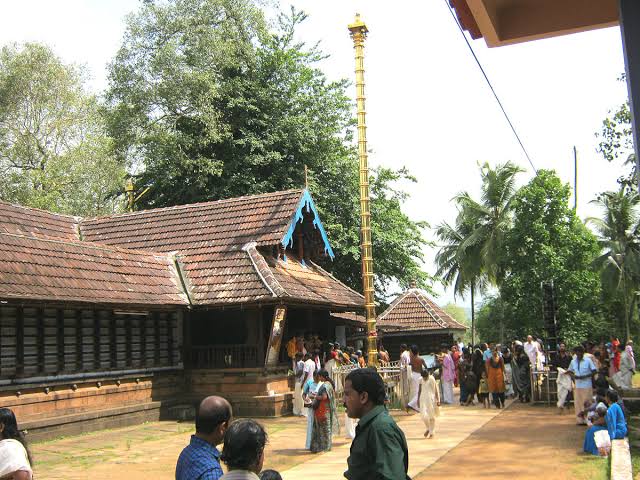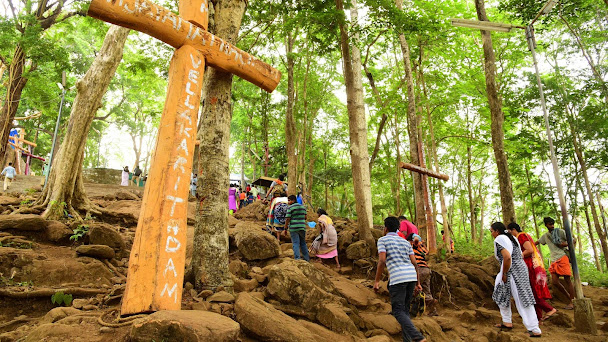The story of Thirumanthamkunnu temple
The northern part of Kerala known as Malabar has seen many rulers grace its soil & the beauty of their rule was the coexistence of different kingdoms. Though many battles ensued over the centuries, the loyalty of the people towards each of their rulers made them rule in harmony. The part of Malabar which had its capital in the current place of Perinthalmanna was ruled by the Valluvanadu Raja & he was called Valluvanadukonathiri. Each ruler had a specific family deity & for the Rajas of Valluvanad, one such temple they revered was the Thirumanthamkunnu temple perched on a hillock in Angadipuram. The name of the temple reached far & wide not much for its legend but for the events that happened later.
Each place of worship has a story or legend behind its existence & one such story is related to this temple where the principal deity is Lord Shiva but Goddess Bhagwathy is worshipped by all devotees. This unique belief is based on the legend of Goddess Parvathy herself. It is believed that King Mandhatha is the one who consecrated the idol here. King Mandhatha belonged to the Suryan Dynasty & he relinquished the throne in search of spirituality, travelled to Kailasa. Lord Shiva happy with the penance asked the King his need. King Mandhata, now a sage, asked for a Shiva Lingam which could be worshipped by him. Lord Shiva is said to have given one among the 9 lingams of Kailas to sage Mandhatha who carried it with him south. Sage Mandhatha wandered the lands & finally came to a hillock which was a dense forest & surrounded on all sides with tall vegetation, birds & wild animals. He decided this place to be the most appropriate & placed the idol on ground which stuck to the ground. Sage Mandhatha lived near the idol & worshipped Lord Shiva on this hillock with others in harmony. Goddess Parvathy who was unaware of all these events upon arriving at mount Kailash was surprised to see that one Shiva lingam which was the most dearest to her had vanished & she asked Lord Shiva about it, he explained the event to her. Goddess Parvathy was not impressed by this as she could not bear the loss & asked Shiva if he would approve her getting the idol back from Mandhata. Lord Shiva said it would not harm his feelings but did warn the goddess that it would be difficult to bring the lingam back to Kailas. Goddess Parvathy was not amused & she asked Bhadrakali & Bhootaganas to go in search of Mandhata & bring back the idol to Mount Kailasa. Bhadrakali & Bhuta Ganas travelled south & found the hill where the Shiva lingam was placed. As the Bhuta Ganas tried to ascend the hill, the bright light from the lingam blinded them & even Bhadrakali found it difficult to see the summit. And it was difficult to ascend, Bhadrakali & the bhuta ganas started throwing their weapons towards Mandhata & his ascetics. The attenders of the lingam worried about this could only find Aathanga nuts from the trees & decided to throw these down the hill in response. It is said that the aathangu nuts took the form of arrows as they came down the hills & hit the bhuta ganas. The Aathangueru (throwing of aathangu nuts) was so harsh that Bhadrakali found it difficult to overcome the resistance & in desperation she took the form of Vishwaroopam. Mandhatha who till now had believed that the adversaries at the base were demons realised that it was Bhadrakali & in sorrow embraced the Shiva lingam asking for forgiveness. Bhadrakali in anger is said to have pulled the lingam from the ground & with a thunder the lingam is said to have split. This event caused a cosmic casualty & the trinity of Lord Brahma, Vishnu & Shiva appeared at the place along with Goddess Parvathy. Lord Shiva was helpless as sage Mandhatha & Parvathy were dear to him so he could not make a decision. Goddess Parvathy realised the dilemma & she told Mandhatha that he could keep the Lingam & as she could not part with the lingam herself is said to have entered the lingam. So from then the lingam has the reverence of Goddess Parvathy which is why the temple is now considered to be a Bhagwathy Kshethram though the presiding deity is Lord Shiva. It was also on the insistence of Goddess Parvathy that the temple also has presence of Bhootaganas & Balaganapathy. It is said that when the lingam was split, Parvathy is said to have appeared with the young Ganapathy who could not be left alone.
For many young men & women & their family the temple is also a place to pray to Ganapathy in a wish to find a good suitor for them in marriage. As per Hindu Mythology, Lord Ganapathy is said to be vighnaharta or remover of obstacles & Balaganapathy at the temple is in the form of a child who can be made happy easily and this belief is what made devotees pray here. For centuries, mangalya pooja has been conducted at the temple for any person who finds an obstacle in getting married. The pooja’s are conducted in periodic terms & every person who finds their suitor after the said rituals is needed to come back to the temple to pray obeisance to Ganapathy. This belief still continues & it is said that any person irrespective of caste or religion can conduct the pooja here.
Though the idol was consecrated during the start of Kaliyugam, the exact date of building the temple is not available. It is believed that sage Mandhatha handed over the responsibilities of the temple to two Brahmins whose descendants still perform the puja here. Sage Mandhatha retired to the forests post this & is said to have passed on using yogic powers. The rulers of Kerala at the time were Perumals & Cheraman Perumal is said to have handed over the kingship of these lands to Valluvanad feudal lords who finished the construction of the temple in its current design. The construction is a simple design based on traditional Kerala architecture & one unique sight are two doors on both sides of the sreekovil which are opened for devotees to see. The Ganapathy kovil where mangalya pooja is conducted is next to the sreekovil & near the moolasthanam. Inside the sreekovil one can find mural paintings which are relatively new & depict stories from the Ramayana. The long set of stairs to the temple are a feature of great design & ascending the stairs is a way to depict the event of Aathangeru. Even today this event is celebrated in its entirety on the first day of the Malayalam month of Thulam when one set of people taking the side of Mandhatha & ascetics hurl Aathangu nuts down the stairs on another set of people depicting Bhadrakali & bhuta ganas. It is indeed a spectacle to see for all who participate in this epic battle.
Though the temple has all its divinity still preserved in its rituals & stories, the temple became the venue of another feud which came about many centuries later. The Mamankam festival was conducted along the banks of the Thirunavaya temple once every 12 years by the Valluvanad kings until the area was taken over by the Zamorin Raja. The chieftains of the Valluvanadu Raja were against this & they decided to end the prominence of the Zamorin raja by vowing to execute him on the last day of Mamankam. These fighters who were selected for this suicidal mission were called chavers & they belonged to four Nair families. The place from where these young men left for the Mamankam festival was the platform one sees at the base of the Thirumanthamkunnu temple called Chaverthara & this single event is considered to be one that is unique in all of Malabar. The venue selected by the chavers to be this temple is based on the reverence of the Valluvanad kings to the Thirumandhamkunnu Bhagwathy & it passes to the Nair fighters who were loyal to their king. Though the chavers were never successful in killing the Zamorin Raja in many Mamankam, the temple became a place which was considered to be the place where the rebels found solace.
The temple celebrates the 11 day long pooram festival & aarattu is a special ceremony conducted during the festival. There is also a thought that the Chottanikkara Bhagavathy temple is also related to the Thirumanthamkunnu Devi who is the younger sister. The temple also does not allow animal sacrifices which is common in Bhadrakali temples. The temple thus is a place not only for one to pray to the deity, fulfil their wishes but also to remember the sacrifices of people who gave their all for the loyalty to their king. A visit to the temple thus will make one realise its divinity & history.




Comments
Post a Comment